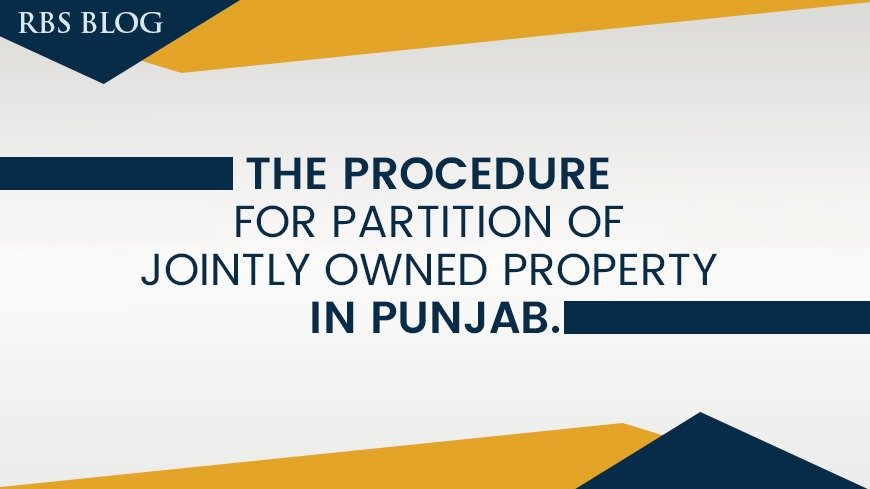- October 1, 2024
- Posted by: Muhammad Shehzad
- Category: Blogs

Whether inherited or purchased, the partition of jointly owned property becomes unavoidable to avoid disputes among its co-owners. The reason behind the dispute is often the disagreement among the co-owners about selling or managing the property. In such circumstances, partition becomes necessary. However, people are generally unaware of the procedure for partitioning jointly owned property, leading to more disputes.
Here, we will best guide you through this procedure, specifically for properties in Punjab.
Grounds for Partition of Jointly Owned Property
According to the Partition of Land under the Land Revenue Act, “Any joint owner of land or joint owner of tenancy can make an application for partition of holding.”
Partition in jointly owned properties often happens when one or two co-owners want to divide the property. The reason could be disagreement, financial need, or any personal reason. The most common grounds for partition are;
- Disputes over inheritance among the family members
- Disagreement on rental incomes or property management
- Desire to develop or sell the property individually
Procedure for Partition of Jointly Owned Property in Punjab
Here is the step-by-step guide to better understand the procedure for partitioning jointly owned property in Punjab.
Step 1: Mutual Agreement or Filing a Partition Suit
The most convenient way for partition is via mutual agreement among all co-owners. They can table talk and mutually agree on dividing the property equally. A lawyer will then formalize the agreement and bind a legal document.
If not, the co-owners will file a petition suit in civil court in the district where the property is located. The plaintiff will be required to provide;
- Ownership documents
- Details of co-owners
- and a detailed map of the property
Step 2: Preliminary Decree
Upon filing the suit, the court will issue a preliminary decree. The decree includes a statement that property should be divided among co-owners and the share of each. The court will also appoint a local commissioner to investigate. He will gather the evidence and report on the best possibility to divide the property.
Step 3: Physical Division or Sale of the Property
The commissioner will present the report in court, and then the court will decide if the property can be divided or needs to be sold to receive the shares from the amount received.
In physical division, the court will specify how the property will be partitioned. However, if the disputed property is a small house or a piece of land, the court will order the sale of the property and divide the proceeds among the co-owners. The share of co-owners will also be specified as per Shariah laws.
Step 4: Final decree
After resolving the disputes and analyzing the local commissioner’s report, the court will issue the final decree. The decree will include the final decision of the court. The document officially partitions the property or orders for sale. After the final decree, the co-owners execute the decision as per the court orders.
Also Read: Understanding Plot Size Conversion in Pakistan
The Role of the Punjab Revenue Department for the Partition of Jointly Owned Property in Punjab
In rural Punjab, the revenue department plays a crucial role in the partition of land, as agricultural land is governed by the Land Revenue Act 1967. The co-owner heads toward the Tehsildar’s office to request a partition. The tehsildar is responsible for issuing notices to all co-owners and investigating them before partition.
Important Considerations for the Procedure for Partition of Jointly Owned Property in Punjab
- A legal representation is necessary to solve property matters smoothly.
- The plaintiff is responsible for paying the court fee when filing the suit. The fee varies according to the property valuation.
- The partition process sometimes takes years, depending on the number of disputes involved and the case’s complexity.
- Disagreement in the final decree, the co-owners have the right to appeal.
What are the Alternatives to Court-Based Partition of Jointly Owned Property?
Understanding the lengthy partition process, the co-owners may prefer resolving disputes through ADR (Alternative Dispute Resolution) methods.
- Mediation: A third party is involved to help the disputing parties reach an agreeable solution.
- Arbitration: A neutral arbitrator hears all the parties and makes a decision to resolve the dispute.
- Negotiation: No outsider is involved, and the co-owners resolve the dispute by negotiating.
- Conciliation: A conciliator is involved, and he actively gives suggestions on how to solve the matter.
Wrap Up
The procedure for the partition of jointly owned property in Punjab through a civil court can be lengthy. However, it guarantees a fair division of rights. Seeking legal assistance throughout the process ensures a smooth procedure without unnecessary drama. It also makes the process less stressful and more efficient.
Review the Punjab Partition of Immovable Property Act 2012 for more details and insights.
FAQS
Who can apply for the partition of jointly owned property/land?
Any joint owner of the land can apply for the partition of the land.
How can a property be partitioned between co-owners in Pakistan?
The partition process is governed by the Partition Act 1893 in Pakistan. In case of legal proceedings, co-owners are subject to following the instructions of the civil court. However, people often prefer out-of-court settlements to avoid lengthy procedures.
What is Section 8 of the Punjab partition of immovable property?
According to section 8 of the Punjab Partition of Immovable Property Act, “When there is a dispute as to the title or share in the immovable property, the Court shall decide such question before proceeding further in the suit under this Act.”
